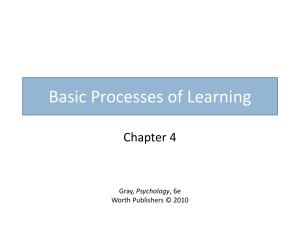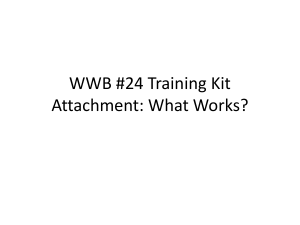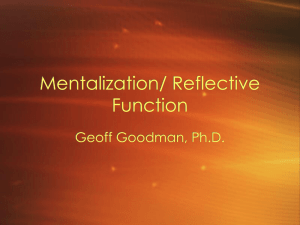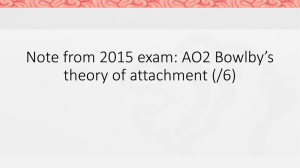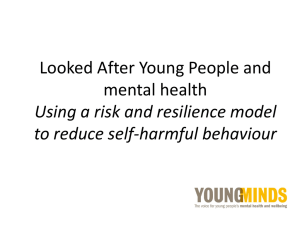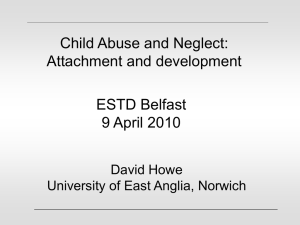Learning theory
advertisement
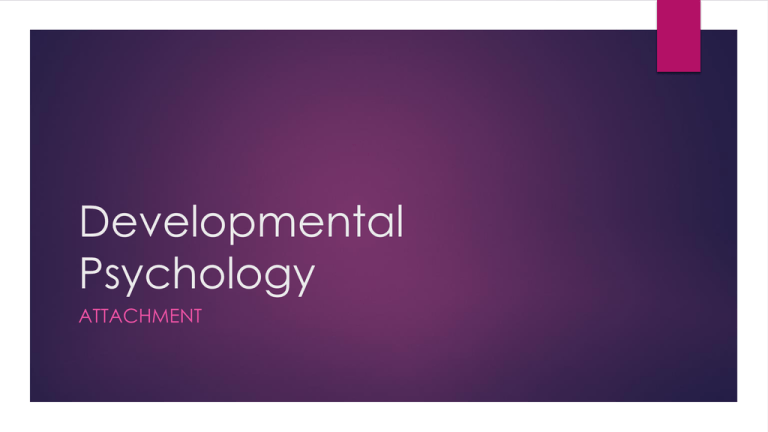
Developmental Psychology ATTACHMENT Learning Objectives To define the term “attachment” To describe and evaluate the learning theory of attachment What is attachment? Explanations of attachment You need to know TWO: - Learning theory - Evolutionary theory - We will be focusing on learning theory today – based on the behaviourist approach – all behaviour is learned Classical and Operant Conditioning http://www.youtube.com/watch?v=H6LEcM0E0io Classical and Operant conditioning How could these be applied to attachment behaviour in infants? Need to talk about DRIVE REDUCTION for operant conditioning Classical Conditioning Learning through association For example, in Pavolv’s dogs, the bell was associated with food, so eventually just hearing the bell would cause the dogs to salivate. Another example, associate the dentist with pain so don’t like visiting the dentist IN ATTACHMENT – FOOD GIVES THE INFANT PLEASURE, MOTHER GIVES INFANT FOOD. THE INFANT THEREFORE ASSOCIATES THE MOTHER WITH FOOD AND PLEASURE AND EXPERIENCES PLEASURE SIMPLY BY BEING AROUND THE MOTHER SO FORMS AN ATTACHMENT Operant conditioning Learning through reinforcement and punishment Positive reinforcement – adding a reward to increase the likelihood of a behaviour occurring – getting a bar of chocolate for washing up Negative reinforcement – taking something unpleasant away increases the likelihood of a behaviour occurring – e.g. not having to do homework if do the washing up Punishment – decreases the likelihood of a behaviour occurring again e.g. detention for not doing homework – means you’ll do your homework next time! IN ATTATCHMENT – BABY IS HUNGRY, BEING FED BY MOTHER REDUCES HUNGER (NEGATIVE REINFORCEMENT AS SOMETHING UNPLEASANT IS BEING TAKEN AWAY) SO MOTHER ACTS AS REINFORCER, OR A SOURCE OF REWARD, SO MAKES INFANT FORM ATTACHMENT TO THEM EVALUATING THE LEARNING THEORY – USE OF RESEARCH EVIDENCE Schaffer and Emerson Studied babies in Glasgow and found that fewer than half of the infants had a primary attachment to the person who usually fed, bathed and changed the infant Responsiveness to infant was more important What does this show? Harlow and Harlow http://www.simplypsychology.org/attachment.html Lorenz http://www.simplypsychology.org/attachment.html http://www.youtube.com/watch?v=MxxrDEbtuag Exam Q When Max was born, his mother gave up work to stay at home and look after him. Max’s father works long hours and does not have much to do with the day-to-day care of his son. Max is now nine months old and he seems to have a very close bond with his mother. Use learning theory to explain how Max became attached to his mother rather than to his father. (6 marks) Mark scheme Learning theory suggests attachment develops through classical and operant conditioning. According to classical conditioning food produces pleasure. Max’s mother was associated with the food and therefore being with the mother causes pleasure too. According to operant conditioning food satisfied Max’s hunger and made him feel comfortable again (drive reduction). Food was therefore a primary reinforcer. His mother was associated with food and became a secondary reinforcer. Max became attached to his mother because she was a source of reward. Social learning theory could also be credited. The explanation must be directly linked to Max and his mother. Answers which make no reference to Max and his mother maximum 3 marks. Summary exam question 1. Describe the learning explanation of attachment (6 marks) 2. Evaluate the learning explanation of attachment. Use research evidence in your answer (6 marks)





